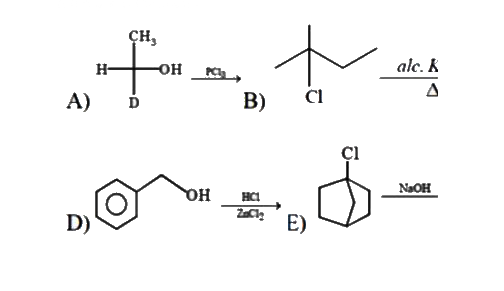Explain why nucleophilic substitution reactions are not very common in phenols ?
Step-by-Step Solution:
1. Understanding Phenols:
- Phenols are compounds that contain a hydroxyl (-OH) group attached to an aromatic ring. The structure of phenol allows for resonance, which is the delocalization of electrons across the aromatic system.
2. Resonance in Phenols:
- In phenols, the oxygen atom in the hydroxyl group has two lone pairs of electrons. One of these lone pairs can participate in resonance with the π-electrons of the aromatic ring. This results in several resonance structures where the negative charge can be delocalized around the aromatic ring.
3. Formation of Resonance Structures:
- When the lone pair on oxygen is used to form a double bond with the carbon atom, the double bond between carbon atoms shifts, creating a series of resonance structures. These structures show that the negative charge can move around the ring, indicating that the aromatic system is stabilized by resonance.
4. Nucleophiles and Their Nature:
- Nucleophiles are species that are electron-rich and can donate an electron pair to form a bond. Common examples include negatively charged ions or molecules with lone pairs.
5. Repulsion Between Nucleophiles and Phenol:
- Since phenol has regions of negative charge due to its resonance structures, introducing another nucleophile (which is also electron-rich) leads to repulsion. Both the nucleophile and the negative charge in the phenol will repel each other, making it difficult for the nucleophile to attack the phenol.
6. Comparison with Electrophiles:
- In contrast, electrophiles are electron-deficient species that can be attracted to the electron-rich aromatic ring of phenols. The presence of negative charge in the ring can facilitate electrophilic substitution reactions, as the electron-rich ring can easily interact with electrophiles.
7. Conclusion:
- Due to the electron-rich nature of phenols and the repulsion between nucleophiles and the negative charges present in the resonance structures, nucleophilic substitution reactions are not common in phenols.
- Phenols are compounds that contain a hydroxyl (-OH) group attached to an aromatic ring. The structure of phenol allows for resonance, which is the delocalization of electrons across the aromatic system.
- In phenols, the oxygen atom in the hydroxyl group has two lone pairs of electrons. One of these lone pairs can participate in resonance with the π-electrons of the aromatic ring. This results in several resonance structures where the negative charge can be delocalized around the aromatic ring.
- When the lone pair on oxygen is used to form a double bond with the carbon atom, the double bond between carbon atoms shifts, creating a series of resonance structures. These structures show that the negative charge can move around the ring, indicating that the aromatic system is stabilized by resonance.
- Nucleophiles are species that are electron-rich and can donate an electron pair to form a bond. Common examples include negatively charged ions or molecules with lone pairs.
- Since phenol has regions of negative charge due to its resonance structures, introducing another nucleophile (which is also electron-rich) leads to repulsion. Both the nucleophile and the negative charge in the phenol will repel each other, making it difficult for the nucleophile to attack the phenol.
- In contrast, electrophiles are electron-deficient species that can be attracted to the electron-rich aromatic ring of phenols. The presence of negative charge in the ring can facilitate electrophilic substitution reactions, as the electron-rich ring can easily interact with electrophiles.
- Due to the electron-rich nature of phenols and the repulsion between nucleophiles and the negative charges present in the resonance structures, nucleophilic substitution reactions are not common in phenols.
Topper's Solved these Questions
Similar Questions
Knowledge Check
- Question 1 - Select One
Which one is a nucleophilic substitution reaction among the following ?
ARCHO+R'Mgx→R−C∣OHH−RBCH3−CH2−oevrset(CH3)∣CH−CH2Br+NH3→CH3−CH2−CH3∣CH−CH2NH2CCH3CHO+HCN→CH3CH(OH)CNDCH3−CH=CH2+H2OH+−−→CH3−C∣OHH−CH3 - Question 2 - Select One
Consider the following anions.

When attached to sp -hybridized carbon, their leaving group ability in nucleophilic substitution reaction decreases in the order :AI gt II gt III gt IVBI gt II gtIV gt IIICIV gt I gt II gt IIIDIV gt III gt II gtI - Question 3 - Select One
Rate of substitution reaction in phenol is :
Aslower than the rate of benzeneBfaster than the rate of benzeneCequal to the rate of benzeneDnone of these
Explain why are electrophilic substitution reactions the most characteristic reactions of benzene?
View SolutionIdentify number of nucleophilic substitution reactions in the given reactions?
 View Solution
View SolutionAryl halides are practically inert toward nucleophilic substitution reactions . The reasons for this fact are
(a) Because C -X bond has partial double bond character due to conjugation bewteen lone pair of X and π electrons of aromatic ring .
(b) No S N 1 reaction beacuase aryl carbocations are unstable
(c) No S N 2 reaction because aromatic π electron cloud do not allow backside attack of N u −
(d) Product obtained through nucleophilic substitution reactions are non aromaticView SolutionChlorobenzene is extremely less reactive towards nucleophilic substitution reaction. Give two reasons for the same.
View SolutionAryl halides are less reactive towards nucleophilic substitution reaction as compared to alkyl halides due to
View Solution

